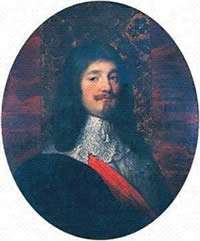Richard Vaughan, 2nd Earl of Carbery

Richard Vaughan, 2nd Earl of Carbery KB, PC (c. 1600 – 3 December 1686),[1][2] styled The Honourable from 1621 until 1628 and then Lord Vaughan until 1634, was a Welsh soldier, peer and politician. He and his second wife are probably best known for the hospitality extended to Jeremy Taylor at his seat Golden Grove (Gelli Aur) during the English Civil War.[3]
Background
He was the only surviving son of John Vaughan, 1st Earl of Carbery and his first wife Margaret Meyrick, daughter of Sir Gilly Meyrick.[4] In his youth he travelled abroad and went to Madrid in 1622.[2]
Early career
Vaughan entered the English House of Commons in 1624, sitting for Carmarthenshire, the constituency his father had previously represented, until 1629.[2] On the coronation of King Charles I of England in 1626, he was made a Knight of the Order of the Bath (KB).[4] Vaughan was appointed Custos Rotulorum of Carmarthenshire in 1630, Custos Rotulorum of Pembrokeshire in 1643 and Custos Rotulorum of Cardiganshire a year later, which offices he held until the English Interregnum in 1646.[5]
English Civil War
A royalist, he succeeded his father as earl in 1634 and joined the Irish House of Lords.[6] Vaughan was called to the bar by Gray's Inn in 1637 and on the outbreak of the civil war in 1642, he received command of a royal army.[2] Fighting in Pembrokeshire in March 1643, he was defeated by Rowland Laugharne and resigned his command, facing impeachment.[2] On 25 October, he was created Baron Vaughan, of Emlyn, in the County of Carmarthen, which entitled him also to a seat in the English House of Lords.[7] In 1644, Vaughan was accused of cowardice and was ordered to pay a fine of £4,500.[2] After advocacy by Laugharne and following correspondence with Robert Devereux, 3rd Earl of Essex in 1646, he was exempted from it and subsequently supported the Parliamentarians to suppress royalist risings.[8]
Later career
With the restoration in 1660, Vaughan resumed his first post as custos rotulorum.[9] He was nominated Lord President of Wales and additionally was given several Welsh lord lieutenantcies.[4] In 1661, Vaughan was sworn off the Privy Council of England and in 1670, he became again Custos Rotulorum of Cardiganshire. Vaughan was lord president and Lord Lieutenant of Glamorgan until 1672, when after charges of abuse against his servants, Henry Somerset, 1st Duke of Beaufort assumed both offices.[6] A year later the duke succeeded Vaughan also as Lord Lieutenant of Anglesey as well as Lord Lieutenant of Brecknockshire. He held however both positions as custos rotulorum until his death in 1686.[9]
Family
Vaughan was married thrice, firstly to Bridget Lloyd, daughter of Thomas Lloyd.[6] After Bridget's death, he married Frances Altham, daughter of Sir James Altham in Acton, London on 8 August 1637 and had by her three sons (Francis, John and Altham) and a daughter.[4] Frances died in 1650 and Vaughan married thirdly Lady Alice Egerton, daughter of John Egerton, 1st Earl of Bridgewater two years later.[10] The earl died in 1686 and was succeeded in his titles by his second son John.[4] His eldest son Francis was the Member of Parliament for Carmarthen when he predeceased his father in 1667.[8] Vaughan's last wife, Alice, survived her husband for three years.[10]
References
- ↑ VAUGHAN family, of Golden Grove, Carms. at Welsh Biography Online (web site of the National Library of Wales) accessed 19 March 2008
- 1 2 3 4 5 6
 Lee, Sidney, ed. (1898). "Vaughan, Richard (1600?-1686)". Dictionary of National Biography. 53. London: Smith, Elder & Co. pp. 171–173.
Lee, Sidney, ed. (1898). "Vaughan, Richard (1600?-1686)". Dictionary of National Biography. 53. London: Smith, Elder & Co. pp. 171–173. - ↑ "Christian Classics Ethereal Library - Jeremy Taylor". Retrieved 9 November 2009.
- 1 2 3 4 5 Burke, John (1831). A General and Heraldic Dictionary of the Peerages of England, Ireland, and Scotland. London: Henry Colburn and Richard Bentley. p. 530.
- ↑ "Institute of Historical Research - Custodes Rotulorum 1544-1646". Retrieved 8 November 2009.
- 1 2 3 "Welsh Biography Online - VAUGHAN family, of Golden Grove, Carms". Retrieved 9 November 2009.
- ↑ Haydn, Joseph (1851). The Book of Dignities: Containing Rolls of the Official Personages of the British Empire. London: Longman, Brown, Green and Longman's. p. 563.
- 1 2 Henning, Basil Duke (1983). The House of Commons, 1660-1690. vol. III. London: Secker & Warburg. p. 627. ISBN 0-436-19274-8.
- 1 2 "Institute of Historical Research - Custodes Rotulorum 1660-1828". Retrieved 8 November 2009.
- 1 2 "ThePeerage - Richard Vaughan, 2nd Earl of Carbery". Retrieved 15 April 2007.
| Honorary titles | ||
|---|---|---|
| Preceded by The Earl of Northampton |
Custos Rotulorum of Cardiganshire 1630–1646 |
English Interregnum |
| Preceded by The Earl of Pembroke |
Custos Rotulorum of Pembrokeshire 1643–1646 | |
| Preceded by Sir Henry Jones, Bt |
Custos Rotulorum of Carmarthenshire 1644–1646 | |
| English Interregnum | Lord President of Wales 1660–1672 |
Succeeded by The Duke of Beaufort |
| Lord Lieutenant of Glamorgan 1660–1672 | ||
| Lord Lieutenant of Anglesey 1660–1673 | ||
| Lord Lieutenant of Brecknockshire 1660–1673 | ||
| Custos Rotulorum of Carmarthenshire 1660–1686 |
Succeeded by The 3rd Earl of Carbery | |
| Preceded by Lord Vaughan |
Custos Rotulorum of Cardiganshire 1670–1686 | |
| Peerage of Ireland | ||
| Preceded by John Vaughan |
Earl of Carbery 1634–1686 |
Succeeded by John Vaughan |
| Peerage of England | ||
| New creation | Baron Vaughan 1643–1686 |
Succeeded by John Vaughan |